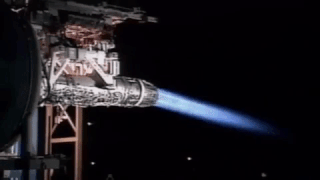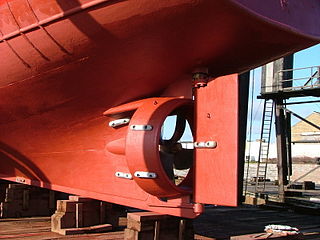
A propeller is a device with a rotating hub and radiating blades that are set at a pitch to form a helical spiral which, when rotated, exerts linear thrust upon a working fluid such as water or air. Propellers are used to pump fluid through a pipe or duct, or to create thrust to propel a boat through water or an aircraft through air. The blades are shaped so that their rotational motion through the fluid causes a pressure difference between the two surfaces of the blade by Bernoulli's principle which exerts force on the fluid. Most marine propellers are screw propellers with helical blades rotating on a propeller shaft with an approximately horizontal axis.

An outboard motor is a propulsion system for boats, consisting of a self-contained unit that includes engine, gearbox and propeller or jet drive, designed to be affixed to the outside of the transom. They are the most common motorised method of propelling small watercraft. As well as providing propulsion, outboards provide steering control, as they are designed to pivot over their mountings and thus control the direction of thrust. The skeg also acts as a rudder when the engine is not running. Unlike inboard motors, outboard motors can be easily removed for storage or repairs.

A runabout is any small motorboat holding between four and eight people, well suited to moving about on the water. Characteristically between 20' and 35' in length, runabouts are used for pleasure activities like boating, fishing, and water skiing, as a ship's tender for larger vessels, or in racing. Some common runabout types are bow rider, center console, cuddy boat and walkaround. The world's largest runabout, Pardon Me, is 48 feet long and owned by the Antique Boat Museum in Clayton, New York.
Sir Charles William Feilden Hamilton was a New Zealand engineer who developed the modern jetboat, and founded the water jet manufacturing company, CWF Hamilton Ltd.

An icebreaker is a special-purpose ship or boat designed to move and navigate through ice-covered waters, and provide safe waterways for other boats and ships. Although the term usually refers to ice-breaking ships, it may also refer to smaller vessels, such as the icebreaking boats that were once used on the canals of the United Kingdom.

Thrust vectoring, also known as thrust vector control (TVC), is the ability of an aircraft, rocket or other vehicle to manipulate the direction of the thrust from its engine(s) or motor(s) to control the attitude or angular velocity of the vehicle.

A pump-jet, hydrojet, or water jet is a marine system that produces a jet of water for propulsion. The mechanical arrangement may be a ducted propeller, a centrifugal pump, or a mixed flow pump which is a combination of both centrifugal and axial designs. The design also incorporates an intake to provide water to the pump and a nozzle to direct the flow of water out of the pump.
A propulsor is a mechanical device that gives propulsion. The word is commonly used in the marine vernacular, and implies a mechanical assembly that is more complicated than a propeller. The Kort nozzle, pump-jet and rim-driven thruster are examples.

The Voith Schneider Propeller (VSP) is a specialized marine propulsion system (MPS) manufactured by the Voith Group based on a cyclorotor design. It is highly maneuverable, being able to change the direction of its thrust almost instantaneously. It is widely used on tugs and ferries.

A Z-drive is a type of marine propulsion unit. Specifically, it is an azimuth thruster. The pod can rotate 360 degrees allowing for rapid changes in thrust direction and thus vessel direction. This eliminates the need for a conventional rudder.

Azipod is a trademarked azimuth thruster pod design, a marine propulsion unit consisting of a fixed pitch propeller mounted on a steerable gondola ("pod") containing the electric motor driving the propeller, allowing ships to be more maneuverable. They were developed in Finland in the late 1980s jointly by Wärtsilä Marine, Strömberg and the Finnish National Board of Navigation.

A surface effect ship (SES) or sidewall hovercraft is a watercraft that has both an air cushion, like a hovercraft, and twin hulls, like a catamaran. When the air cushion is in use, a small portion of the twin hulls remains in the water. When the air cushion is turned off ("off-cushion" or "hull borne"), the full weight of the vessel is supported by the buoyancy of the twin hulls.

Manoeuvering thrusters are transversal propulsion devices built into or mounted to either the bow or stern of a ship or boat to make it more manoeuvrable. Bow thrusters make docking easier, since they allow the captain to turn the vessel to port or starboard side, without using the main propulsion mechanism which requires some forward motion for turning; The effectiveness of a thruster is curtailed by any forward motion due to the Coandă effect. A stern thruster is of the same principle, fitted at the stern. Sufficiently large vessels often have multiple bow thrusters and stern thrusters.

The Kitchen rudder is the familiar name for "Kitchen's Patent Reversing Rudders", a combination rudder and directional propulsion delivery system for relatively slow speed displacement boats which was invented in the early 20th century by John G. A. Kitchen of Lancashire, England. It turns the rudder into a directional thruster, and allows the engine to maintain constant revolutions and direction of drive shaft rotation while altering thrust by use of a control which directs thrust forward or aft. Only the rudder pivots; the propeller itself is on a fixed shaft and does not.

Marine propulsion is the mechanism or system used to generate thrust to move a watercraft through water. While paddles and sails are still used on some smaller boats, most modern ships are propelled by mechanical systems consisting of an electric motor or internal combustion engine driving a propeller, or less frequently, in pump-jets, an impeller. Marine engineering is the discipline concerned with the engineering design process of marine propulsion systems.
Internal drive propulsion or water-jet propulsion is a form of marine propulsion used in recreational boating. Like other forms of motorized boating, internal drive propulsion employs a motor that turns a propeller to move the boat forward. The primary difference between internal drive boats and external drive boats is that the propeller is enclosed inside the hull of an internal drive boat whereas the propeller is exposed outside the hull of a stern drive, V-drive or straight shaft drive boat.

A Schilling rudder is a specific type of profiled rudder used on certain boats and ships. The rudder is typically described as 'shaped like a fishtail'.

A ducted propeller, also known as a Kort nozzle, is a marine propeller fitted with a non-rotating nozzle. It is used to improve the efficiency of the propeller and is especially used on heavily loaded propellers or propellers with limited diameter. It was developed first by Luigi Stipa (1931) and later by Ludwig Kort (1934). The Kort nozzle is a shrouded propeller assembly for marine propulsion. The cross-section of the shroud has the form of a foil, and the shroud can offer hydrodynamic advantages over bare propellers, under certain conditions.

HMS Waterwitch was one of only three armoured gunboats built for the Royal Navy. Uniquely, she was powered by Ruthven's "hydraulic propeller", making her the first ship to employ waterjets. She was launched in 1866 and conducted comparative trials with her two sister ships. She was not employed operationally and was sold in 1890.
Schottel is a manufacturer of propulsion and steering systems for ships and offshore applications. The company founder Josef Becker invented the rudderpropeller, a z-drive, in 1950. Today the company develops and manufactures azimuth propulsion, maneuvering and steering systems. In 2014 the subsidiary Schottel Hydro was founded to bundle up the company activities in the hydrokinetic energy segment.





















